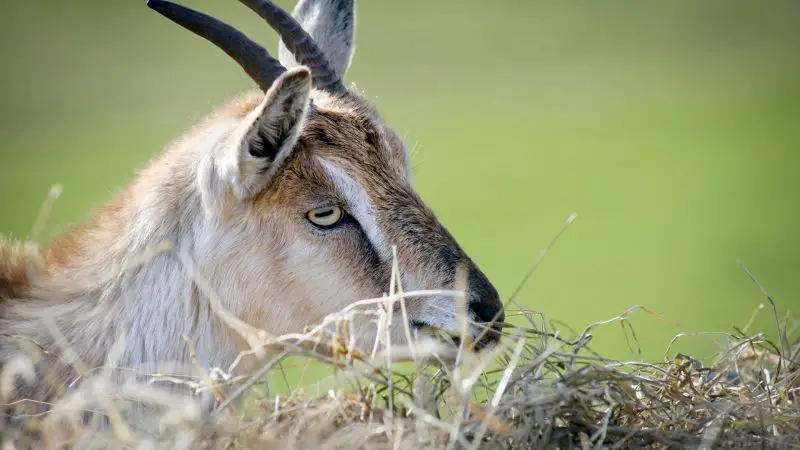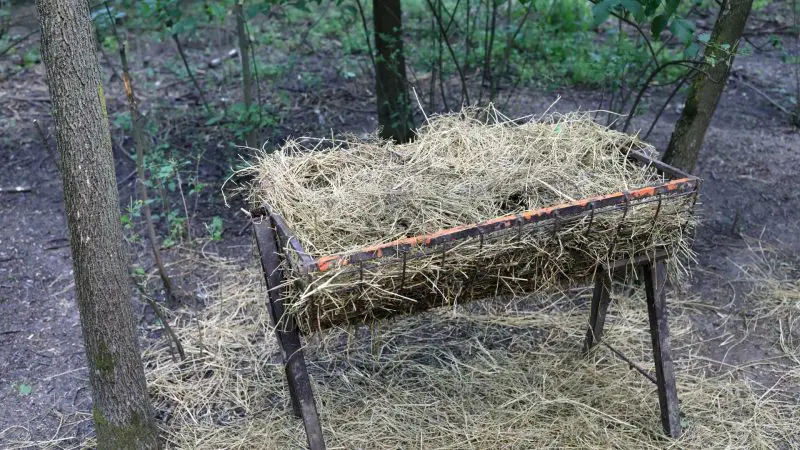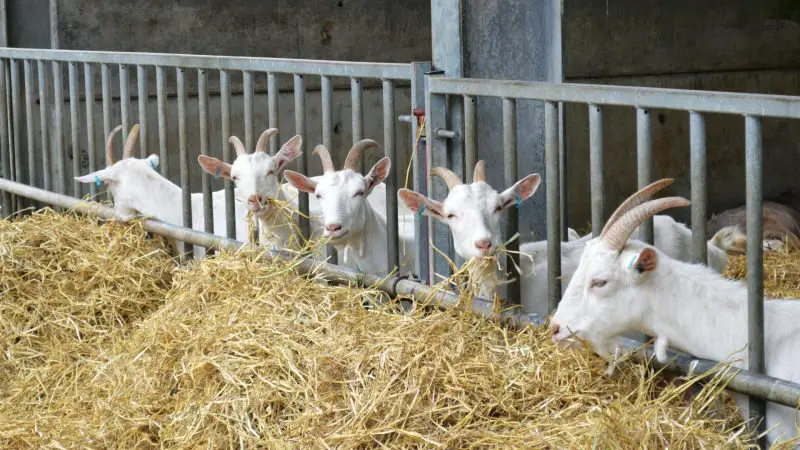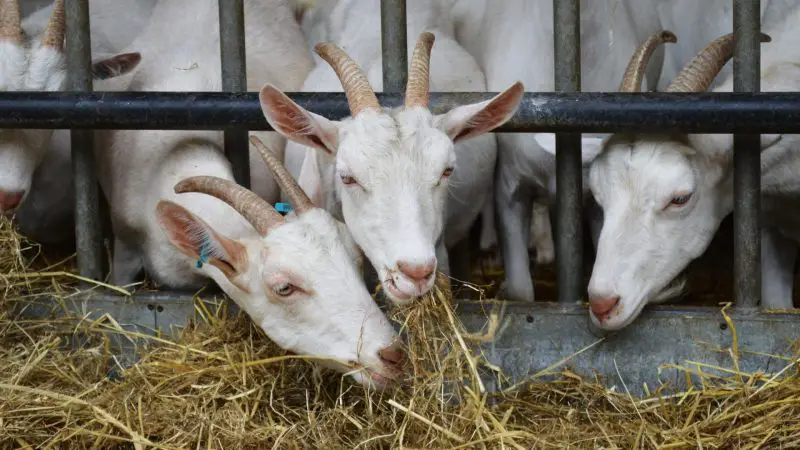Raising goats or sheep is a good investment, but it comes with some responsibilities. Since their health and safety should be your most concern, you should know how to feed them properly.
Aside from providing them with clean water and surroundings, you should also choose the right feed and feeders.
What is the best hay feeder for goats and sheep? The best hay feeder for them is the one that helps you reduce hay waste while allowing your goat and sheep to enjoy feeding. Among them are made by trusted companies such as Behlen Country, Little Giant, Apple Picker, Gaun, and Intrepid International.
To start with, goats are browsers while sheep are grazers, like cows. Although both of them can be fed with hay, they have different nutritional requirements. In this complete guide, you will learn how to reduce hay waste, know what they should eat and should not eat, and how to choose the best hay feeders for them.
How Do You Keep Goats From Wasting Hay?

According to estimates, wasted hay for feeding can reach up to 60%. This can be due to fecal contamination, physical and chemical deterioration due to poor storage and unstable weather conditions, and refusal of farm animals to eat them. Therefore, here are some ways to prevent your goats from wasting hay:
1. Don’t give goats excess hay.
Although excess hay can still be used later as a soil protector, it is no longer good for feeding goats. As much as possible, give your goats the amount of hay that they can only consume in a day. To have an idea of the right amount, separate your goats during feeding or better yet, put a temporary barrier between them.
2. Don’t put hay on soil.
Goats can be very picky at times and are not keen on eating dirty or wet food. Molds can also easily grow in wet hay, which will eventually spoil. Most of them also hate eating hay on the ground, especially if another goat has already tasted it and rejected it. This is the main reason why you should not put hay on the soil.
3. Avoid feeding on the same area.
Feeding your goats in the same area repeatedly can eventually result in muddy soil, soil compaction, and excessive sod destruction, especially during winter. Aside from avoiding mold to grow on hay, feeding your goats in different areas can also help spread manure more uniformly, which can improve soil fertility.
4. Feed your goats on high traffic area pads.
If your space is not enough for feeding in different areas, try constructing a so-called high-traffic area pad. This pad is any solid surface that is usually made of gravel, concrete, or geotextile fabric. This material improves drainage in areas that are susceptible to water and mud accumulation, especially during winter.
5. Reduce giving loose hay.
Loose hay is very beneficial to goats not only because it has high nutritional value. It also increases saliva production due to traditional chewing, and forage slows overall consumption. But because goats waste a lot of loose hay, you may want to reduce its supply and give them baled hay or hay pellets as alternatives.
6. Put hay on hay feeders.
So far, hay feeders are the best way to reduce hay waste during feeding. Generally speaking, a hay feeder is a feeder with some gaps or holes so that goats can get only the amount of hay they can eat. However, the holes should be small enough to avoid the goat’s horns getting stuck in them while getting hay.
7. Use hay nets.
Hay nets are usually intended for horses but can also be used for goats. Just like feeders, hay nets have small gaps so that goats can only get what they can eat. Durable hay nets such as Bloomoak Slow Hay Net for Horse and Goat are made of nylon rope. Nevertheless, they should be hanged so hay won’t get dirty.
8. Feed goats with high-quality hay.
No matter what feeding method or hay feeder you use, your goats will still not eat hay that has poor quality and will rather waste it. Goats know the taste of high-quality hay, and you cannot force them to eat something they don’t like. To make sure your hay has very high quality, bring it first to a forage testing laboratory.
How Do Hay Feeders Work?
Hay feeders work like any kind of feeder, where goat owners put hay manually. In most cases, hay feeders have V-shaped racks. These feeders have small holes or gaps so that goats will only take limited amounts of hay. They are usually elevated or have a solid panel at the bottom to help reduce hay waste.
What Are the Types of Hay Feeders for Goats and Sheep?

Hay feeders come in different designs, sizes, and materials used. Although all of them have the same purpose, not all of them are compatible with your needs. Therefore, here are the most common types of hay feeders you can choose from:
1. Round or Square Bale Feeders
The baled hay can be round or square (large and small), and each has its advantages and disadvantages. Round bales are cheaper than square bales but will consume more space. When choosing either round or square bale feeders, make sure that your goats or sheep can reach the center of the feeder.
2. Walk-Through Feeders
Walk-through feeders are usually placed in the middle of two pens so that goats from both pens can eat at the same time. Here, goat farmers can walk through the end of the feeder to put hay without disturbing the goats, hence the name. They can also have a large feeding capacity, although you need a wider space.
3. Trough Feeders
Trough feeders are similar to walk-through feeders, except that they are placed away from the pens. Interestingly, most designs can be used for both hay and grains. These feeders are usually elevated and have drain holes, so hay stays dry. They also have a long bar above to prevent goats from climbing to the feeder.
4. Fence Line Feeders
As the name suggests, fence line feeders are placed on the fence of the pens. Here, goat farmers can put hay (or grain) into the feeder without entering the pen. Hence, your goats can eat peacefully while inside their pens. However, the length and number of feeders will only depend on the size of the pen fence.
5. Hay Nets
Hay nets are the cheapest among them all and are ideal for reducing hay waste. They also consume less amount of space, are handy, and can be hung anywhere. However, they are quite hard to fill and are only ideal for kids and younger goats. Goats also prefer bending their necks downward while eating.
What to Consider in Choosing the Best Hay Feeders for Goats and Sheep?
Choosing the best hay feeders for your goats or sheep can be tricky. As a responsible farm animal owner, you want them to feel relaxed and comfortable during feeding. So, before buying feeders for them, here are some very important factors you should consider first before buying them:
1. Feeder Size
Choosing the feeder size mainly depends on how many goats you have and their ages. Expect also that an entire herd (group of goats) may sometimes eat at the same time. Experts recommend 8-12 linear inches of feeder space for a single self-fed doe (female goat), and 16 inches of feeder space for a limit-fed goat.
2. Materials
Hay feeders can be made of different materials such as plastic, stainless steel, or wood. Plastic is probably the cheapest but can easily get knocked down by goats. Stainless steel is the most durable material but is the most expensive one. On the other hand, wooden hay feeders are common and are the easiest to modify.
3. Design
Hay feeders can also be wall-mounted, hanged, or to be placed on the ground. Wall-mounted hay feeders can save some space, but only a few goats can eat at the same time. Hanging feeders (hay nets) greatly reduce hay waste but are not usually applicable for adults, while floor-placing feeders are ideal for adults and kids.
4. Safety
Both male and female goats can have horns, although some of them are hornless, which are called polled goats. If your goats have horns, make sure the gaps or holes in the feeder are small enough so their horns will not get stuck inside the feeder. Note that polled goats can get their heads tangled in them.
5. Price
Price matters a lot, especially if you are on a tight budget. Most of the time, price dictates the quality and design of a product. But then, some cheap hay feeders are also durable and dependable. Therefore, it’s better if you first compare the prices from different manufacturers and read the reviews from certified buyers.
What Is the Best Hay to Feed Goats?

Hay is any type of grass that has been cut, dried, and stored as feed for farm animals such as cattle, horses, sheep, and goats. Hay has two main categories – grass hay and legume hay. Grass hay includes bluegrass, Bermuda grass, fescue, timothy, and orchard grass, while legume hay includes alfalfa and clover.
The nutritional content of hay mainly depends on its maturity after it was cut and baled. So far, the only way to know the best hay to feed goats is to bring the hay to a laboratory for forage analysis. Here are the common types of hay and their crude protein content, crude fiber content, and Total Digestible Nutrients (TDN):
Alfalfa
- Crude protein: 19%
- Crude fiber: 26%
- TDN: 61%
Clover
- Crude protein: 15%
- Crude fiber: 30%
- TDN: 55%
Fescue
- Crude protein: 11%
- Crude fiber: 30%
- TDN: 52%
Orchardgrass
- Crude protein: 10%
- Crude fiber: 34%
- TDN: 59%
Bermuda Grass
- Crude protein: 10%
- Crude fiber: 29%
- TDN: 53%
Timothy
- Crude protein: 8%
- Crude fiber: 34%
- TDN: 57%
Bluegrass
- Crude protein: 6%
- Crude fiber: 40%
- TDN: 45%
Judging from the data above, alfalfa has the highest crude protein content and TDN. Therefore, alfalfa is considered the best hay for lactating goats (does). However, consumption of too much protein is a common cause of bloating, which can lead to death. Therefore, goats should be fed with alfalfa moderately.
Can You Feed Sheep Feed to Goats?
You can also feed your goats with sheep feed. However, making drastic changes in feeding your goat may lead to digestion problems.
You should give time for their rumen (the goat’s largest stomach and is responsible for the initial digestion of food) to adjust. Therefore, you should introduce a new feed gradually.
Note also that goats and sheep have different nutrient requirements. Depending on their age, the crude protein requirement for goats is 10-15%, while sheep need 9-15% of crude protein.
Goats also need 10-80 ppm of copper, while sheep only need 20 ppm of copper. This means that goats need more copper than sheep.
How Much Hay Do You Feed a Goat?

Ideally, a goat should consume hay at 3-4% of its body weight each day. This is equivalent to around 2-4 pounds of hay every day. You can feed your goat twice a day or free choice. But still, the exact amount of hay your goat needs depends on the type of hay. This is also why you should know how heavy your goat is.
What Is Toxic to Goats?
Goats are known for eating almost anything that they can chew. This includes grass, grains, hay, shrubs, tree bark, vegetables, and weeds.
On the other hand, goats may also accidentally eat plants that can poison them. In fact, there are over 700 toxic plants that goats should not eat. Below are only some of them:
Toxic Plants That Can Make Goats Sick
- Bladderpod
- Cassia
- Chokecherry
- Coffee senna
- Croton
- Elderberry
- Lantana
- Lilies
- Milkweed
- Pokeweed
Toxic Plants That Can Kill Goats
- Boxwood
- Bracken Fern
- Cherry Laurel
- Chinaberry
- Chinese Tallow
- Cocklebur
- Coral Ardisia
- Crotalaria
- Crowfoot
- Ivy
- Goat Weed
- Horse Nettle
- Jimsonweed
- Johnson Grass
- Lily of the Valley
- May Apple
- Mountain Laurel
- Nightshade
- Oaks
- Oleander
- Philodendron
- Pines
- Poison Hemlock
- Potato (unripe)
- Rhododendron
- Rosary Pea
- Sago Palm
- Sicklepod
- Spotted Water Hemlock
- Tomato (green parts, unripe)
- Yellow Jessamine
Tips for Making DIY Hay Feeders for Goats and Sheep
If you are hesitant to buy goat hay feeders, you can easily make one on your own. In doing so, you can freely choose the size and design you like. And of course, you can also save some money. To help you out, here are some useful tips on how to make DIY (Do-it-yourself) goat feeders.
- For the materials, you can use an old barrel (or old plastic trash can or bucket), an old baby crib, a water tote, or wooden pallets.
- If you will use an old barrel, simply bore small holes around it just enough for your goats to put their heads inside to get hay.
- To avoid being knocked down by goats, put some cement blocks at the bottom.
- If you will use an old baby crib, make the base height fixed so that it will not go up and down.
- Dismantle two opposite sides and screw them inside an angle of about 45 degrees each to form a letter V, which will serve as the feeder.
- If you will use a water tote, you can also modify it to include the letter V inside. Just make sure there are no excess burs that can harm your goats.
- If you will use wooden pallets, which are very cheap and sometimes free, you will need 4 of them. You might also need some wood scraps.
- Use the 2 pallets for the sides (walls) and the other two for the letter V, just like in the old crib.
Note: In all of these designs, you might want to add flooring to catch falling hays and a cover to protect the hay, in case your goats get on top of the feeder.
Best Hay Feeders for Goats and Sheep
There are many commercial hay feeders to choose from, but some of them may not be worth buying. In this section, you will have an idea of some of the best hay feeders for your goats and sheep. Each of them has great quality, lots of positive reviews from real customers, and comes with very affordable prices.
1. Behlen Country 74023327 8-Feet V Trough Feeder
This sturdy Behlen Country V Trough Feeder is 8 feet long, weighs 63 pounds, and is made of alloy steel. The V-shaped trough provides convenience to owners while putting in feed. The feeder is 14 inches above the ground, making it easier for goats to get hay. Lastly, each end has drain holes to prevent standing water.
2. Gaun 60630 Individual Sheep Liner
This Gaun Individual Sheep Liner is made from galvanized sheets and can also be used for goats. Standing at 21 inches tall, this excellent feeder has latches so you can adjust the height. The trough is also big enough to help reduce hay waste. But more importantly, you can hang it anywhere or put it on the ground.
3. Little Giant Classic Heavy-Duty Galvanized Metal Goat and Sheep Feeder
This versatile Little Giant Goat and Sheep Feeder is designed for hay and grain feeding and can hold 2-3 flakes of hay. Made from durable galvanized metal, this free-standing feeder has two strong hooks for easy mounting on your pen fence. It can accommodate 10 adult goats and sheep and is easy to assemble.
4. Little Giant Plastic Fence Feeder with Clips
This Little Giant Plastic Fence Feeder has an ergonomic design, which makes it ideal not only for hay but also for grains. Aside from having clips for easy hanging, it also has a chain for additional support. Made from polyethylene resin, this durable feeder does not easily warp, break, and crack due to stress.
5. HAY and Grain Feeder Boxed
Manufactured by Apple Picker, this all-metal Hay and Grain Feeder has metal bars for hay and a metal box for grains. This portable but durable feeder has a dimension of 30 x 16 x 22 inches, allowing 2 adult goats (or sheep) to eat at the same time. Weighing at 48 pounds, you can easily hang it on bars or pen fences.
6. Intrepid International Hay Rack Wall-Mounted
Manufactured by Intrepid International, this heavy-duty hay rack is made of 1/2-inch round steel bars. Despite having a very simple design, this hay feeder has no sharp edges, making it safe for your goats while feeding. It also has 2 hooks for easy mounting on barns and a large opening, so you can easily put hay.
Summary
Giving the right feed and using the best hay feeders are major components in goat farming. In doing so, you are not only keeping them healthy but also protecting them from diseases. And as much as possible, you would want to prevent them from wasting hay. After all, hay is also part of your investment.
List of Sources
Minimizing Hay Waste While Feeding
